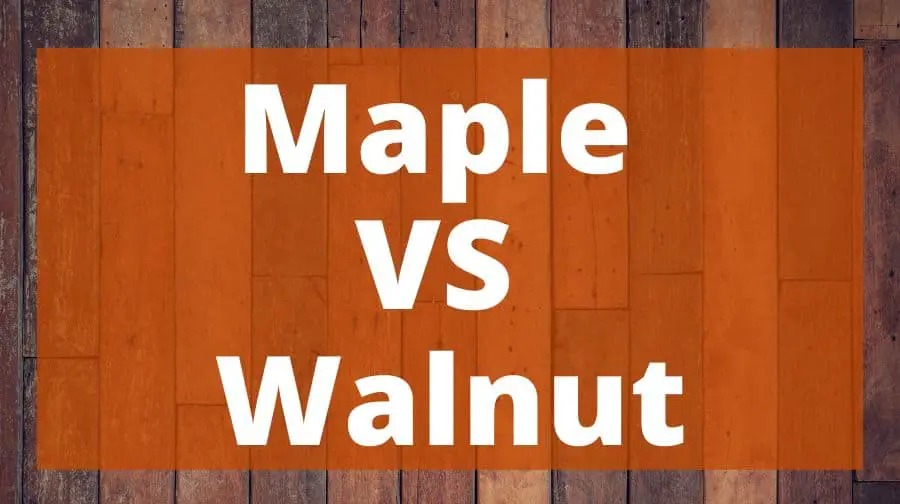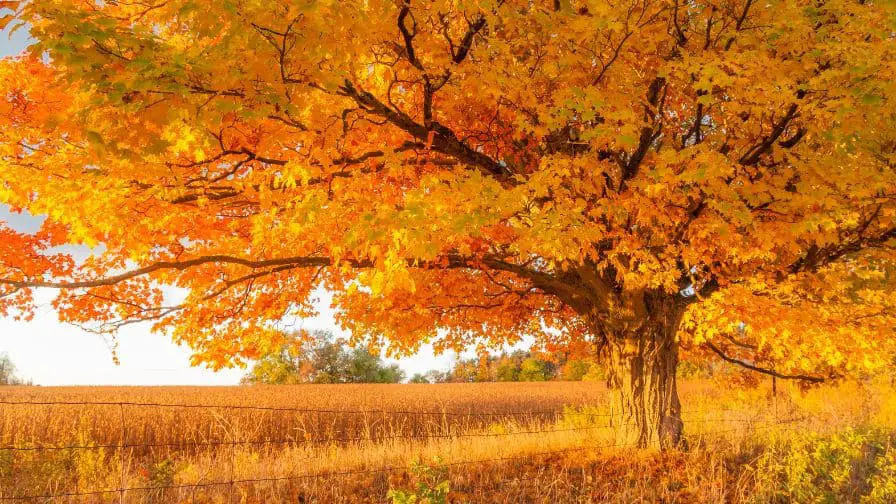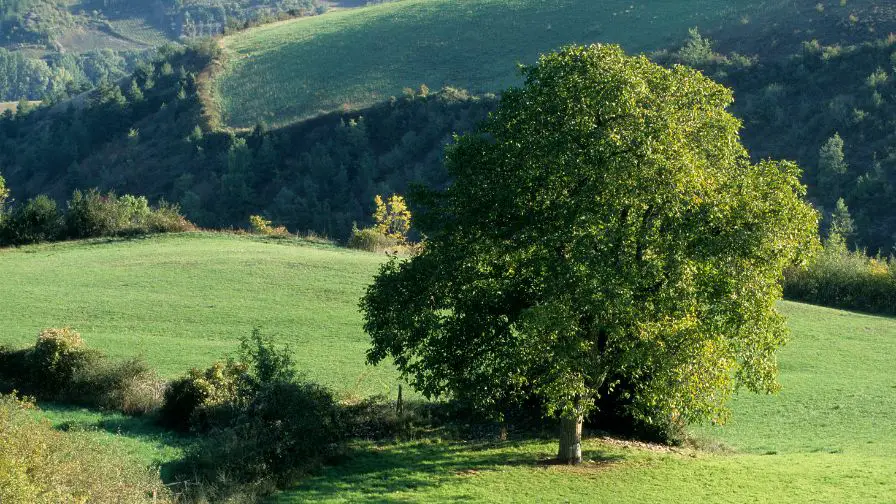
It’s the age-old question: which is better, Maple or Walnut? Both have their own unique set of qualities that make them appealing to different people. Some might prefer the sweetness of Maple, while others might appreciate the robustness of Walnut.
In this article, we will take a closer look at Maple vs Walnut and see how they compare in terms of appearance, strength, and price. We will also discuss some of the pros and cons of each type of wood so that you can make an informed decision about which one is right for you!
Table of Contents
What Is Maple Wood?
Maple wood is a type of hardwood that is derived from maple trees. It is a popular choice for furniture and flooring because of its durability and strength.
Maple wood has a smooth grain that can be stained or painted to suit your needs. It is also a relatively lightweight wood, making it easy to work with.
It is available in a variety of colors, including white, red, and brown. It comes in difference quality grades, depending on the tree it came from.

What Is Walnut Wood?
Walnut wood is a type of hardwood that is typically used in the construction of furniture and cabinets. It is also a popular choice for floors and paneling. Walnut wood has a dark brown color with a straight grain pattern.
Walnut wood is available in two main types: black walnut and walnut. Black walnut is the more expensive of the two types.
Walnut wood is available in two different grades. Grade A walnut wood is the highest quality and is typically used in high-end furniture. Grade B walnut wood is of lower quality and is often used in lower-priced furniture or for construction purposes.
Walnut wood is a hardwood that is strong and durable. It is also resistant to warping and twisting. It is easy to work with and takes stain well.

MAPLE VS WALNUT
| CATEGORY | MAPLE WOOD | WALNUT WOOD |
| PRICE | The price of Maple wood varies depending on the quality of the lumber and can range from $10.99-$13.99/board foot. You can order natural, high character and premium walnut boards. If you order in bulk you can get cheaper pricing. | The price of Walnut wood varies depending on the quality of the lumber and can range from $11.99-$20.99/board foot. You can order natural, high character and premium walnut boards. If you order in bulk you can get cheaper pricing. |
| JANKA HARDNESS | Maple Janka Hardness score is 1450 | Walnut Janka Hardness score is 1010 |
| DURABILITY | Maple’s durability makes it ideal for flooring in high traffic areas like kitchens and hallways. It can take a beating without showing wear and tear, which is why it’s often used in commercial settings. | Walnut, on the other hand, is not as durable as Maple. It is more susceptible to scratches and dents. However, walnut’s strength lies in its ability to resist warping and splitting. |
| SPECIES | Maple species is called Acer and it belongs to the Sapindaceae family. | Walnut species is called Juglans and it belongs to the Juglandaceae family. |
| TREE SIZE | Maple trees average between 50 and 80 feet tall. In terms of spread, maples average between 30 and 50 feet wide. Maple tree leaves are usually between three and six inches wide and five to seven inches long. | Walnut trees are generally smaller, averaging between 20 and 60 feet tall with a spread of 50-75 feet. Walnut tree leaves are larger, darker green, and have a rough texture. Walnut trees have a more rounded canopy. |
| LOCATION | Maple trees are native to North America and are grown extensively in the United States, Canada, and Europe. Maple trees prefer a cool climate and generally do not grow well in tropical or subtropical regions. | Walnut trees are native to the Mediterranean region but are also grown in other parts of the world including North America, Europe, and Asia. Walnut trees prefer a temperate climate with well-drained soil. |
| COLOR | Maple wood is typically light in color ranging from nearly white, to a pale caramel. There are some varieties of maple with slightly darker colors, but not by much. Maple trees blossom with small, red flowers in the springtime. | Walnut wood is typically a chocolate brown color with darker streaks running through it. Walnut wood may also have a slightly purple hue to it. Walnut, on the other hand, has a more consistent color. It is usually a dark chocolate brown but can also be found in lighter shades. Walnut blossoms are greenish-yellow. |
| GRAIN | Maple wood grain is very tight and uniform with pores that are barely visible to the naked eye. Maple also has a very smooth surface this makes it an excellent choice for furniture that will see a lot of use, as it can withstand dings and scratches better than other woods. | Walnut wood grain is straight grained and pores are much larger and more spaced out. Walnut wood grain is more open with a looser feel and a rough texture. The grain of walnut is also much more pronounced than maple. |
| END GRAIN | Maple End Grain is very popular in cutting boards because it is very hard, close grained wood that does not dull knives. | Walnut End Grain is smooth, with small, uniform pores arranged in a spiral pattern. Walnut on the other hand is a softer more open grained wood that will show knife marks more readily. Walnut also has a limited range of colors and grain patterns. |
| ROT RESISTANCE | Maple’s rot resistance is due to a naturally high tannin content. Tannins are water-soluble, and they’ll leach out of the wood over time, especially if the wood is repeatedly exposed to water. This leaching process makes maple more resistant to decay. | Walnut’s rot resistance is due to the chemical properties of juglone and its low density. Walnut is a relatively soft wood, and its low density makes it more difficult for decay-causing fungi to penetrate the wood. |
| SUSTAINABILITY | Maple trees can be harvested at around 35 years old, while walnut trees take upwards of 50 years to reach maturity. This difference in maturity levels means that maple trees can provide a more sustainable source of wood for furniture and other products. | Walnut trees can be harvested after reaching maturity between 40-60 years old. It is not as sustainable because it is a less common resource and takes longer to grow. |
| USES | Maple wood can be used for a variety of things including flooring, furniture, cutting boards, cabinetry, boxes, utensils and even musical instruments. | Walnut wood can be used for furniture, cabinetry, gunstocks, veneers, interior paneling, cutting boards, marquetry inlays, checkboards, flooring, millwork, desks, dining tables and butcher blocks. |
| RELATED SPECIES | Maple related species are found throughout the northern hemisphere, including North America and Europe. There are about 128 species in the Acer genus such as the sugar maple, red maple, and silver maple. Most are deciduous, but a few are evergreen. | Walnut related species are found mostly in the southern hemisphere but some grow in the northern hemisphere as well. There are about 30 related species of walnut including black walnut, butternut, and heartnut. walnuts are evergreen. |
Subscribe to Forest Farming on YouTube
MAPLE VS WALNUT: PROS & CONS
| MAPLE | WALNUT | |
| PROS | The pros of Maple wood are that it is typically harder than walnut, more resistant to scratches, and has a lighter color. | The pros of Walnut wood are that it is very strong and durable. Walnut is also a popular choice for furniture because it has a beautiful grain pattern. Walnut can be stained or painted to match any decor. |
| CONS | The con of Maple wood are that it has a uniform grain formation making it a less unique looking wood. | The cons of Walnut are that it is susceptible to scratches and dents. Walnut is also a bit more expensive than some other types of wood. |
Maple wood is best for:
-Smoking meats
-Making furniture
-Creating flooring
Maple wood is a strong, durable hardwood that has a variety of uses. It is most commonly used for smoking meats and making furniture, but can also be used for creating flooring and other woodworking projects. Maple wood is a popular choice for many because it is easy to work with and has a beautiful grain pattern.
Walnut wood is best for:
-Making high-quality furniture
-Creating beautiful floors
-Constructing cabinets and other storage solutions
If you’re looking for a wood that will give your home a luxurious look and feel, then walnut is the way to go. This type of wood is often used in high-end furniture and flooring, as it has a rich, dark color that really makes a statement.
It’s also perfect for constructing cabinets and other storage solutions, as it is both strong and stylish. So if you’re looking to add a touch of luxury to your home, then walnut wood is the way to go.
What Is The Difference Between Maple And Walnut?
The differences between maple and walnut trees are:
- Maples produce a sweet sap that is often used to make syrup, while walnuts produce a bitter sap that is not suitable for consumption.
- Maple leaves are typically arranged in pairs, while walnut leaves are alternate.
- The fruit of a maple tree is a samara (or key), while the fruit of a walnut tree is a nut.
- Walnut is darker than maple.
What’s Darker Maple Or Walnut?
Walnut wood is darker than maple wood. If you’re looking for a dark wood, walnut is a good choice. It has a deep, rich color that can add sophistication to any space.
If you’re looking for a lighter wood, maple is a good option. It has a light-medium color with subtle grain patterns. Maple is also a hardwood, so it’s durable and easy to care for.
Is Walnut Better Than Maple For A Cutting Board?
No, walnut is not better than maple for a cutting board because it’s close grain doesn’t dull knives and walnut’s softer more open grain wood shows knife cuts in the wood.
End Grain Cutting Board-Maple and Walnut
Subscribe to joe pompili on YouTube



